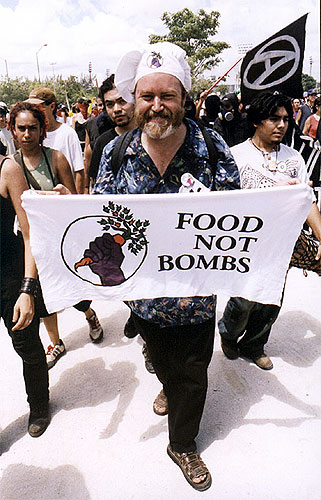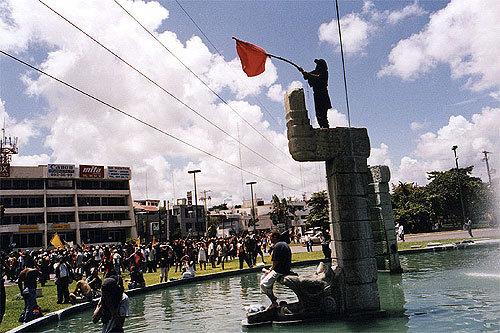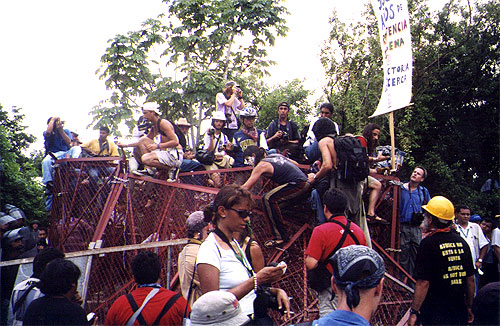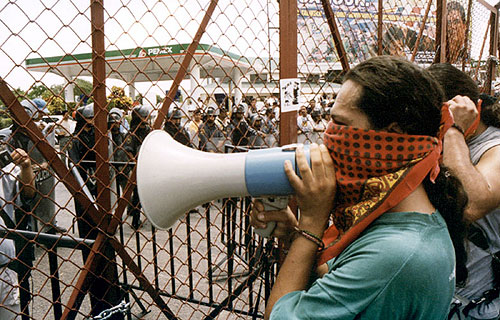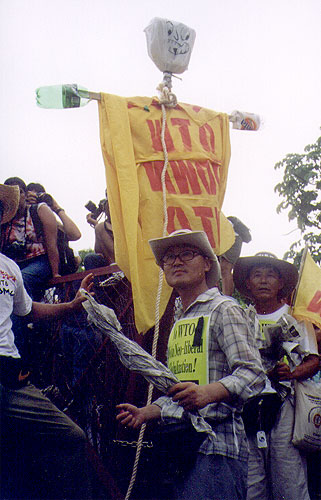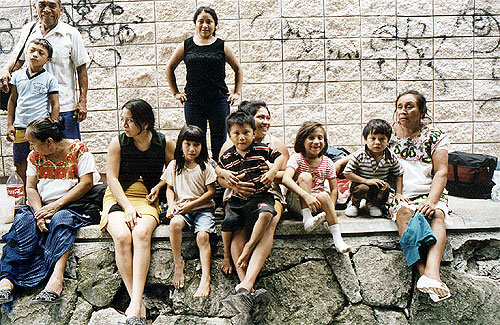On September 3, 1958, Charles Moore, a young photographer for the Montgomery Advertiser, witnessed an argument between the Rev. Martin Luther King Jr. and two policemen on the steps of the City Recorders’ Court. Moore’s good fortune that day was in stark contrast with King’s. Moore was the only member of the media to witness King’s subsequent arrest, and his picture of the minister being manhandled during the police booking became one of the most significant photographs of the civil-rights movement. King was taken to the back of the jail where he was frisked, roughed up, and tossed into a cell.
When Life picked up the picture from the Associated Press wire, it would be the first of Moore’s celebrated civil-rights photos to be published in the magazine. Having witnessed many of the most significant events of the era, by 1965, the photographer would grow weary of years of hatred, violence, street battles, and the searing taste of tear gas. After documenting the fight surrounding James Meredith’s bloody admission to the University of Mississippi, the dogs turned on protesters in Birmingham, and the savagery of the civil-rights march at Selma, Moore booked an around-the-world ticket on Pan Am and didn’t return home for eight months.
Through the work of Moore and other heralded photographers such as Flip Schulke and Gordon Parks, Life — along with King’s savvy for spreading his message through the media — is credited with giving national prominence to what had been a regional story until the mid-1950s. During the 1950s and ’60s, the weekly Life was the nation’s most influential media outlet, reaching more citizens than any television program and read by more than half the adult population of the United States.
Although many letters to the editor protested Life’s so-called “liberal bias” in covering civil rights, the magazine was also criticized for its conservatism. When it published eleven pages of Moore’s graphic photos of rioting in Birmingham, Alabama, in May 1963, it described the movement as a “crusade” and used sympathetic headlines such as “The Dogs’ Attack is Negroes’ Reward.” However, the same article criticized King’s non-violent but provocative actions.
The pictures on these eleven pages are frightening. They are frightening because of the brutal methods being used by white policemen in Birmingham, Ala. against Negro demonstrators. They are frightening because the Negro strategy of “nonviolent direct action” invites that very brutality — and welcomes it as a way to promote the Negroes’ cause, which, under the law, is right.
Indeed, the article quoted no blacks at all and followed with a sidebar interviewing 16 Birmingham whites. In the introduction to the interviews, Life said, “The Negroes of Birmingham know what they want and how they want to get it. The white people of the city, shaken by recent events, are perplexed about what to do.” Moore felt that the magazine’s only bias was in its zeal to right the wrongs of desegregation. Despite being a southern, white male he was sickened by the injustice that he witnessed while covering the civil-rights movement.
In his 1964 book about the violence in Birmingham, Why We Can’t Wait, King’s comments illuminate the drama contained in Moore’s photos and the power of the national media, of which Life was most influential: “The brutality … was caught — as a fugitive from a penitentiary is often caught — in gigantic circling spotlights. It was imprisoned in a luminous glare revealing the naked truth to the whole world.”
Like King, Moore had been the son of a Baptist minister. The photographer was reared in Tuscumbia, Alabama, living in a poor white community as “a real tough little kid who grew up in a community of tough kids.” His father would invite Charles along, as he was sometimes invited to preach in the normally segregated black churches nearby. Although he knew few blacks growing up, he remembers that a kind man once walked him home when he became lost and wandered into a “colored town” when he was six. He credits his father’s insistence that that no racial epithets be uttered in the family’s house for his own tolerance. “Although my Dad had few black friends, he told us never to use the ‘n’’ word,” Moore said.
Moore had not set out to be a news photographer. After a stint in the Marine Corps and training in fashion photography at the Brooks Institute in Santa Barbara, California, he returned home to Alabama and settled for a job photographing in an Olan Mills portrait studio. Although the industrious Moore was soon offered a job as regional manager for the studio chain, he went to Montgomery to see the local newspaper’s chief photographer, Joe Holloway. As the first of Moore’s photographic mentors, Holloway was impressed with the 26-year-old’s knowledge of a Rolleiflex camera and ability to build a rapport with models on the site of a fashion shoot.
When he began working at the paper in 1957, Moore had no knowledge of the national story that had occurred in Montgomery just a year before: Rosa Parks, a local seamstress, had refused to ride in the back of a city bus, as was the rule in the South, touching off a massive boycott. “To be honest, I was a young kid. I didn’t know what was going on in the world. I had no interest. My head was into camping, wildlife and fashion. I wanted to photograph beauty,” he said. He had no idea that his pictures to come would do far more than help publicize King’s efforts; they would also lead to national outrage culminating in President Johnson’s signing of the Civil Rights Act of 1964. By that time, Moore’s dramatic Life photos were given credit for helping to influence the legislation’s passage.
Fueling the movement
Before King was arrested on the courthouse steps, Moore had met him briefly on a routine assignment at the Dexter Avenue Baptist Church just a few blocks down from the paper. As a typical southern newspaper of its time, the Advertiser relegated “Negro news” to a separate section. Still, the paper did not ignore the growing national prominence of its local minister and Moore soon began to realize the importance of the role he was playing:
When I met Dr. King, I was just at the beginning of my career. I never knew black people on a personal level because there was segregation. I had been to his church meetings and didn’t have to go to many to be absolutely fascinated by this man. When I went down to meet him, I shot him at the pulpit with a cross behind his head. I got down low to get the power of this man. I have to say, ‘Yeah, I was on my knees to King.’ I became fascinated [by the] the power of his oratory. From then on I wanted to cover him. I wanted every assignment I could get.
In September 1958, King attempted to enter a crowded courtroom for a hearing involving his fellow pastor and key aide, Ralph Abernathy. Moore had heard that King might be there, and on his own initiative decided to drop by. “The police were telling him he couldn’t go in and were giving him a hard time. He said, ‘I’ll just stay here [on the courthouse steps]’ and refused to leave,” Moore said.
Moore recalls that the two inexperienced officers suddenly decided to arrest King, unaware of who he was. His wife, Coretta, protested but was told, “Just nod your head and you’ll go to jail, too.” Although King was not being pushed, one officer twisted the minister’s arm as the three walked a block and a half to the police booking area. “I saw an opening on the other side of the counter. I ran there real quickly. Nobody stopped me and I quickly took a few frames from behind the counter,” Moore said.
When the picture went out on the wire, two Life staffers appeared in town the next day, photographer Gary Villete and “a guy who later became managing editor.” They got in touch with Moore, who invited them to his home for dinner, his first meeting with the magazine.
At the time, Moore did not understand the significance of his picture, but many others did. During the next two days, the national press corps poured into town. Rather than pay a fine for loitering, King was intent on serving his 14-day jail sentence. To diffuse further publicity, Police Commissioner Clyde Sellers released him, saying that he was merely saving the taxpayers money by paying King’s $10 fine. “King was a master at using the media. The significance was that the whole world was aware that Martin Luther King had been put in jail,” Moore later realized.
When the picture was published in Life twelve days later, Moore was pleased but wished the magazine could have published his eight-picture sequence of the incident instead of just a single photo. Once before, Life had published a full-page fire picture of Moore’s but editors chose not to give prominent play to King’s arrest. The photograph occupied one-sixth of a page and was used with three other pictures accompanying a story about “mostly quiet” civil-rights integration. Stories given far more dominant play in the same issue included “Chinese ‘Reds’ impose a blockade on Quemoy” and an article about fixing charges on television quiz shows. A prominent story on race riots in Britain also dwarfed the coverage of unrest at home.
Even with the understated play in Life, the photo’s publication in the influential magazine triggered further outrage and a rush of financial aide for King’s Montgomery Improvement Association. Although he had once been asked to appear on television’s Meet the Press, King was now even better-known on a national level; his influence would soon grow to a fevered pitch. By the next time King was photographed by Moore during an arrest, the photographer would be on assignment for Life.
Moore makes his mark as a freelancer
By 1962, Moore had been his newspaper’s chief photographer for four years after Holloway had moved on to a career at United Press International. He was ready for a change and decided to take a room in the French Quarter of New Orleans for a 10-day shooting vacation. He met the wife of local district attorney Jim Garrison, who would later rise to prominence with his controversial views on the assassination of John F. Kennedy. Garrison helped Moore gain access to the late-night world of jazz bars, musicians and stripper — subjects that were otherwise off-limits to outsiders. “When I got back to the paper, I knew I wanted to travel more and reach out to a new audience,” Moore said. He gave two weeks’ notice and moved to New York, anticipating a lucrative freelance career there.
“It didn’t work. I spent three months and was hanging out in the West Village. I hated New York and my money was going.” Before heading back to Alabama, Moore befriended Milt Freir, a representative from Leica who urged him to go see Howard Chapnick, the influential founder of the Black Star picture agency. In his book, Truth Needs No Ally, Chapnick described Moore as disenchanted. “He had come to New York to make his way into photojournalism and after three months had found a cold, unyielding and professionally unrewarding city.”
Chapnick decided to give Moore a small weekly guarantee. “We talked and Howard liked the idea I was giving up New York. ‘I think you can do some really good work down there,’ he told me,” Moore remembers. Chapnick would later credit Moore with documenting the important events that defined the movement.
Rather than encourage Charles Moore to stay in New York to pursue his career, I told him I felt one of the great stories in American history was unfolding in the South. He came from the South and understood it. Going back to Alabama to document the events taking place there would provide the chance for Charles to do work he was uniquely qualified for.
Still, upon his return to Montgomery, Moore faced another two months of frustration. He missed the newspaper and had little to do. “I felt like a stranger in hell back in Montgomery. I was struggling,” he said. But Moore had a sudden turn of luck when he ran into Life‘s Miami bureau chief, Dick Billings, in Oxford, Mississippi.
Black student James Meredith had attempted to register at the University of Mississippi and the state’s defiant governor, Ross Barnett, ignored a federal court order by declaring himself the university’s emergency registrar, personally and physically barring Meredith. The governor was seen as a folk hero in his state and hated what he saw as Life’s liberal bias, refusing to be photographed or interviewed. Moore’s contacts from five years of covering state government paid off as he assured Billings that he could get a picture.
After being granted exclusive access to photograph Barnett, Moore says that he did not dare mention the word ‘Life.” The editor was thrilled with the pictures. “After today, you’re working for us,” he was told. At the time, a mob of more than 2,000 was descending on the college town, intent on blocking Meredith at any cost.
Moore’s ascent to the ranks of Life photographers could not have come at a more dangerous time. U.S. Attorney General Robert F. Kennedy sent 200 federal marshals down to protect Meredith and each other. Several other Life shooters were on the scene, some with combat experience. With two days to go before federal marshals would attempt to escort Meredith to his first class, Moore knew that it would be a violent weekend.
Word got out that he was working for the magazine. A pack of enraged white students shoved their way into Moore’s hotel room, shouting and cursing. One began to choke him before the former Golden Gloves boxer pushed him away. “I’ve never seen such hate in anyone’s face before. It was like I were vermin … To him I was worse than ‘a nigger,’ I was a white nigger. And worse than that I was a white Life magazine nigger.”
On the street, the mob waved confederate flags. Some even loaded guns as they waited for Meredith’s arrival, not knowing he had already been hidden at a campus dormitory. Local law enforcement, urged on by the governor, was defiant of the federal authorities as well, intent on preventing the enrollment of the first black student there. One of Moore’s most chilling photographs showed local plain-clothes policemen chuckling while one practiced a swing with a billy club before the start of the inevitable rioting. “They were talking about what they’re going to do to Bobby Kennedy and the U.S. Marshals, laughing and showing how they would take care of them,” Moore said.
Moore had to make some quick decisions. The marshals had blocked the campus, forbidding the press to go in. Readily identifiable as a news photographer, he was threatened again. “I was told, ‘You nigger lovers had better go home’ … and that this guy and his brother were out with their shotguns looking for me.” After buying a gas mask at a local Army-Navy store, Moore sneaked onto the campus with the help of a brave student who he remembers only as ‘John.’ The student drove a VW beetle and Moore stashed his cameras in the vehicle’s trunk. “The cops searched the car but didn’t search the trunk, which was up front. That’s how I got in,” he said.
It was Sunday evening and as darkness fell, the rioting began. The mob had surrounded the school’s administration building, the Lyceum, and started slashing tires and throwing rocks. Soon it was a siege. Earlier, Moore had decided to bluff his way into the building, where 200 unarmed marshals were holed up. Accompanied by a freelance writer who was also working for Life, Moore banged on the door, telling the guard that he was desperately ill and had to go to the toilet. The ruse worked and the two were forgotten about in the ensuing chaos. Outside, cars were set on fire, and when a lead pipe knocked a marshal unconscious, the lawmen began to fire tear gas into the mob. Moore darted outside for a short time but again talked his way back in. “If you stayed outside and used a flash, you would die. Molotov cocktails were being thrown all over,” he said.
It was no safer inside. As soon as marshals fired the gas into the crowd, it would drift back inside, filling the building. Moore wore a gas mask through the evening as he photographed the wounded marshals, several shot and bleeding. After hearing about the melee, then-President John F. Kennedy decided to send in federal troops but they would not arrive until the next day. Deputy Attorney General Nicholas Katzenbach was trapped inside the building, and Moore overheard him pleading on the telephone with Bobby Kennedy:
‘They’ve got guns out there, Bobby, they’ve got guns. Our men are being shot . . .’ He was trying to convince Kennedy to let them have weapons to protect themselves and Kennedy said no. They had billy clubs, that’s all. The marshals were shooting tear gas to keep the crowd from rushing them. They even stole a bulldozer and were attacking the building with it.
When it was over, twenty-eight marshals had been shot and 160 were injured. Moore had been the only photographer inside and had exclusive shots of the wounded. Later he learned that a French reporter and a local repairman had been killed in the night-long battle. “We put our lives on the line. I was just sitting on a trash can in front of the building, surrounded by smashed TV cameras and tear gas canisters. We were totally wiped out,” Moore said.
The magazine’s reporters and photographers were ordered to rest up in a Memphis hotel room. One of the correspondents made up a mock press card, called a ‘SCREW’ card, standing for ‘Southern Correspondents Reporting Equality Wars.’ For his bravery, Moore was issued the first one. “I’m real proud of that because I have card No. 1,” he said. He received a phone call from Black Star telling him that Life was overwhelmed with his work. For the next three years, he would earn the reputation as the photographer most able to gain uncanny access to the front lines of the civil-rights cause.
A 13-page layout in the October 12 issue was dominated by Moore’s work. But some of the letters to the editor that were published on October 26 and November 2 were critical of both the magazine and the federal involvement in the university’s affairs. One letter complained about stereotyping when the magazine wrote, “A blood-covered red-neck is propelled in the door, guided by two angry marshals.” Carolyn P. Nemrow, of Boston, wrote, “President Kennedy has enough of the nation’s journalistic sheep jumping to give its condemnation of Ole Miss Affairs. When will people realize that the issue is not Meredith, it is state sovereignty versus ever-growing federal intervention.”
Of barking dogs and walls of water
Moore soon moved to Miami, and after considering a job with the Miami Herald, was promised steady work with Life by Billings. He was often teamed with reporter Michael Durham and in April 1963, the two were assigned to cover rising tensions in Mississippi and Alabama. After William Moore, a mailman, was shot and killed while walking to protest segregation, Moore photographed protesters along “The Freedom March” that followed a path through three states.
At nearly the same time, Martin Luther King Jr. was arrested for organizing protests by school children and from jail would write his famous treatise outlining his philosophy of civil disobedience. Although a state injunction had been issued against King’s protests, he responded by saying, “We’ve got an injunction from heaven.” Moore had a strong picture of King and Abernathy walking toward their inevitable arrest along with a series from the march. However, neither story was published in the magazine. One of the biggest American news stories of the century, the Bay of Pigs — the failed, U.S.-led attack on Cuba — pushed civil rights out of the pages of Life for a time.
The most influential pictures of Moore’s career were taken over five days beginning on May 3. Birmingham was considered the nation’s most segregated city, and the photographer had a hunch that he and Durham should go to the city after hearing reports on the radio about escalating tensions there. Five minutes after the journalists arrived in Kelly Ingram Park, the scene of anti-segregation demonstrations, firemen had been ordered by Police Commissioner Bull Connor to bring out their hoses to contain the swelling crowd.
Moore crawled on the pavement and took a position between the firemen and the protesters, who were being pummeled by a virtual wall of water. The scene disgusted Moore but he felt a responsibility to keep shooting. One of the firemen told him later, “We’re supposed to fight fires, not people.”
One of Moore’s most remarkable photographs showed three students forced against a brick wall by a fierce spray of water propelled at 100 pounds per square inch. Fourteen-year-old Carolyn McKinstry was unaware at the time that she was being photographed. “After getting hit with the hose, that was the last thing on my mind. Dr. King had had motivational meetings with us. He had never mentioned the water hose but said there might be dogs and they might even spit on you,” she said in a 1998 interview.
When she saw her picture in Life two weeks after the demonstrations, McKinstry had no special feeling about seeing herself in a national magazine, saying that she was still fearful and angry from the experience. However, a teenager at the time, she did remember being displeased at seeing her hair in disarray. Later, McKinstry would become appreciative of the sensitivity in Moore’s graphic photographs. Before the Birmingham unrest, she had said, “The black community had lost any trust that there could be a fair portrayal by the photographers. We were always portrayed in a negative light.”
The protests continued for five days as King urged the demonstrators, many of them children, to return to the park. Some of the scores of angry onlookers were not schooled in the preacher’s philosophy of passive resistance; Moore was struck in the ankle by a large chunk of concrete. Despite searing pain and an injury to his tendons, he continued to work for the next three days after treatment by a black doctor. “He did that story half-crippled,” Durham said.
When the demonstrations did not abate, Connor ordered police dogs into the crowd and urged the officers to allow whites to view the demonstrations. “I want them to see the dogs work,” he said. Along with the fire hose images, the pictures of dogs snarling and ripping at the pants of protesters would be among the most dramatic of Moore’s career. Despite knowing that he was making meaningful photographs, Moore felt revulsion. “Attack dogs — that was repulsive,” he said.
As the demonstrations spread, Moore and Durham disobeyed a police order not to go outside the park and were arrested as they attempted to document a woman being knocked down by the water from the hoses. Locked up in a cell for four hours with Durham and about a dozen menacing white men, Moore, known as a fearless photographer, faced one of the most frightening experiences of his career. “We could have been beaten very badly if they would have known we were from Life.” Another reporter from the magazine bailed them out. Facing the possibility of a six-month jail term in an unsympathetic city, Life’s lawyers advised Moore and Durham to skip town immediately and fly to New York. The charges were later dropped but for a year, Moore was a fugitive from justice in his own state, having to sneak home once to see his own children in Dothan.
At Life, Moore was given the rare opportunity to supervise the 11-page layout, and the magazine’s editors decided to give him his first byline. His photos inspired seven letters published in the June 7 issue — three critical and four sympathetic to the civil rights cause. Francis Pharr Jones, of Austin, Texas, wrote, “We assume the guilt of the white supremacist when we allow this persecution … I shall never forget those tragic faces.” Grady Franklin, of Crawfordsville, Indiana, wrote, “Charles Moore’s photographs on the racial troubles in Birmingham were superb and bone-chilling — surely a candidate for the Pulitzer Prize in news photography.”
The photos of the dog attacks and fire hoses have been among the best-selling of all time at Black Star, reprinted time and again in books and magazines. Picture editor Yukiko Launois recalled that there were many photographers working in the South at the time, but “I remember Charles’ photos, particularly of Birmingham, as the most memorable and distinguished.” Several others had also photographed the violent confrontation between police dogs and protesters. “Somehow, Charles’ image was better. Only Charles’ became a classic. From the beginning, Charles Moore was identified with that image.”
Politicians noticed as well. John F. Kennedy said that the situation in Birmingham had sickened him and mentioned the riots there in a speech the next month in which he asked Congress to initiate civil-rights legislation. Militant black leader Malcolm X mentioned the dog attacks in a speech that he gave in Africa. Senator Jacob Javits of New York later credited Moore’s Birmingham photographs with helping to quicken passage of the Civil Rights Act of 1964. Historian Arthur Schlesinger Jr. later said that the police-dog photographs transformed the national mood and made the legislation not just necessary, but possible. A year after Moore’s classic photos were first published in Life, Martin Luther King was awarded the Nobel Peace Prize.
Even artist Andy Warhol noticed Moore’s best-known photo of a snarling dog reared up on its hind legs while another bit the buttocks of a protester. One morning in 1964, Howard Chapnick and his wife, Jeanette, were eating breakfast when the Black Star chief noticed a Time magazine article about Warhol’s latest work. Chapnick immediately recognized that one of the featured paintings, Red Race Riot, was a slightly altered silkscreen of Moore’s photograph. “Howard has eagle eyes. He might not remember what he had for breakfast but never forgets a picture,” said Jeanette Chapnick.
The painting was a clear copyright violation without credit to either Moore or the agency. Chapnick insisted that Moore go personally to Warhol’s studio to confront him. Not comfortable with negotiating with the flamboyant artist and his assistant, Moore settled for two flower prints and Warhol’s promise that he would be credited whenever the painting was reproduced (Later it was found that the flower series had itself been appropriated from a photograph in a Burpee seed catalog). In the years to come, Warhol failed to follow through on his promise of crediting the photograph and both Black Star and Moore sold their flower prints soon after obtaining them. The Warhol watercolor was not considered an appropriate match for the famous news photos adorning the walls at Black Star. “It had no place hanging with the photography. We sold it and had a lot of trouble getting rid of it. I think we got $250 for it,” said Jeanette Chapnick.
Knowing when to duck and when to shoot
Moore and Durham traveled together frequently through the South, covering the dangerous skirmishes that defined the black struggle for equality. When they first met in a Tennessee airport to cover the 1963 Freedom March, Life’s editors had thought it wise to team a Southerner with a Northerner. Moore’s Alabama drawl blended in but when he heard Durham’s Yankee accent, the reporter recalled Moore’s first words to him. “‘At least you look like a redneck. But when we’re together, don’t say anything.’ That’s a funny thing to say to a reporter but it was definitely good advice. It was best the rednecks didn’t know who you were in those years,” Durham said.
The two quickly became friends and looked out for each other during the many urban battles they covered. In order not to miss crucial pictures during fast-breaking riots, a system was worked out where Moore would run backwards at full speed as he photographed, led by the collar through the crowd by Durham.
Chapnick told Moore that he could not believe that in Birmingham, the photographer’s longest telephoto lens was a modest 100 millimeters. Often, the reporter would help out by carrying a lens or even Moore’s camera bag during tense events. In June 1963, in Jackson, Mississippi, a riot broke out as the two covered the funeral of Medgar Evers, the first black civil-rights leader to be assassinated. Durham remembers the event as the only time that the usually kind and soft-spoken Moore ever spoke harshly to him.
It was in the heat of action. He turned and said to me, ‘Give me the lens!’ ‘What do you mean,’ ‘Give me the lens?’ I replied. He said, ‘I gave it to you.’ I said, ‘No, you did not.’ We went back down the street and saw a red-haired kid standing there holding the lens. Charles asked him, ‘How did you get the lens?’ This kid turned and said to Charles, ‘‘You told me, Here. Hold this.’ All the time Charles thought it was me.
In June 1964, Moore and Durham were assigned to cover the disappearance of three white Northern college students who came to the South to help register black voters. After being jailed in Philadelphia, Mississippi, the three vanished shortly after their release. Later they were found murdered and the Life team found themselves working in their most hostile environment yet.
“All the journalists will tell you that Philadelphia, Mississippi was the most frightening place of all,” Moore said. Because they had rented a car and taken a hotel room, word spread quickly among townspeople that outsider reporters were there to cover the murders. As Moore photographed the search for the bodies, a local man tried to knock a camera out of his hand. “As we were driving the back roads, our bumper got bumped.” For protection, “in the motel, we put a chair in front of the door.”
- Follow us on Twitter: @inthefray
- Comment on stories or like us on Facebook
- Subscribe to our free email newsletter
- Send us your writing, photography, or artwork
- Republish our Creative Commons-licensed content






